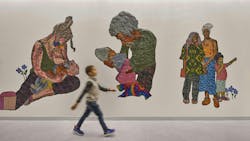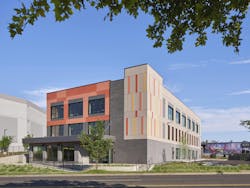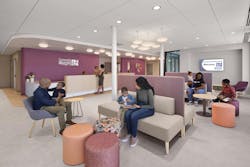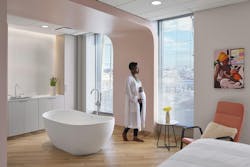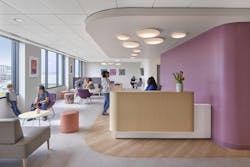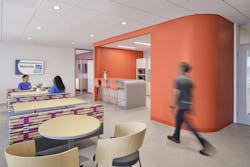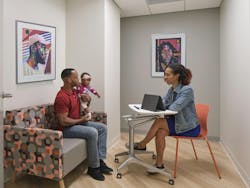Community of Hope and Gensler Expand Health Facility to Combat Healthcare Inequalities in Washington, D.C.
The United States is a nation of “firsts,” many of which have cemented its standing as a global leader in industries from space travel to manufacturing, and innovation to transportation. Unfortunately, the healthcare industry isn’t one of them—at least as far as equity is concerned.
By nearly any measure, the U.S. exhibits a level of health inequity rarely seen among developed nations. This inequity stems from deep and complex roots, influenced by disparities in income, education, race, segregation and geographic location.
To address healthcare inequalities in the nation’s capital, Community of Hope partnered with Gensler to expand their Family Health and Birth Center. Situated in northeast Washington, D.C., Community of Hope is dedicated to delivering high-quality healthcare to underserved and underrepresented populations. By repurposing an existing building shell and incorporating sustainable design practices, Community of Hope and Gensler have created a new facility that not only meets the healthcare needs of the community but also fosters a supportive and celebratory environment for local residents.
“Community of Hope’s overarching mission for the Family Health and Birth Center is to improve health equity in the nation’s capital by expanding care to pregnant individuals and their families,” said Bonny Slater, global healthcare practice leader and design director at Gensler. “To accomplish that mission through design, it was crucial that our team at Gensler developed a safe, warm and welcoming space for whole-person care. As a result, the space accommodates a fully equipped birthing center, medical clinic, behavioral health services, pharmacy and lab access, a multipurpose space for group visits and community events and an entire third floor workspace for staff and providers—with bright colors, custom artwork and soft forms to create a place of hope and joy,” she added.
With an emphasis on expecting mothers and their babies, this innovate facility provides an array of services for families. Working within a tight program-to-footprint ratio, the space accommodates a fully equipped birthing center, 15 exam rooms, behavioral health services, tele-health services, pharmacy access, conferencing spaces, a large multipurpose space, labs with associated support, and an entire third floor workspace for staff and providers.
As D.C.’s only nationally accredited birth center, it was crucial that this project reflected the vision and personality of its community members, Slater explained. “As we began the design process, we hosted discovery workshops with local families who experienced both hospital and birth center deliveries, which heavily influenced the experiential and aesthetic direction, creating soft, curvaceous, and approachable spaces. Based on the community’s feedback,” she said, “the birth suites are designed without anything clinical in appearance to avoid triggering traumatic hospital birth experiences. Shades of pink and orange, comfortable beds, and a statement bath all create a home-like setting within the birthing suites, designed for comfort and calm.”
Utilizing every square foot of the building, Gensler worked diligently to provide efficient and well executed space planning. The overall space was custom-made to deliver the best patient care experience possible
This unique project also leaned heavily on the personal influences of community members. Inspired by these individuals, Gensler developed project-based solutions that catered to the custom needs of the user. From materiality to the equipment needed to provide the best care, the interior was designed to embrace and celebrate natural birth while providing a space that felt comfortable and approachable.
Over the years, an increasing number of women with low-risk pregnancies have opted for birth centers over hospitals, Slater noted. “They are drawn to the personalized attention, home-like settings, support for natural birth, and greater control over their birth experience. They’re also drawn to the lower cost and improved health outcomes compared to hospital births,” she added.
“Against the backdrop of disproportionately high maternal and infant mortality rates for women of color, a midwifery-led birth center with providers representative of the community is an important step towards building trust in healthcare,” Slater concluded.
About the Author
Robert Nieminen
Chief Content Director
Chief Content Director, Architectural Products, BUILDINGS, and interiors+sources
Robert Nieminen is the Chief Content Director of three leading B2B publications serving the commercial architecture and design industries: Architectural Products, BUILDINGS, and interiors+sources. With a career rooted in editorial excellence and a passion for storytelling, Robert oversees a diverse content portfolio that spans award-winning feature articles, strategic podcast programming, and digital media initiatives aimed at empowering design professionals, facility managers, and commercial building stakeholders.
He is the host of the I Hear Design podcast and curates the Smart Buildings Technology Report, bringing thought leadership to the forefront of innovation in built environments. Robert leads editorial and creative direction for multiple industry award programs—including the Elev8 Design Awards and Product Innovation Awards—and is a recognized voice in sustainability, smart technology integration, and forward-thinking design.
Known for his sharp editorial vision and data-informed strategies, Robert focuses on audience growth, engagement, and content monetization, leveraging AI tools and SEO-driven insights to future-proof B2B publishing.
